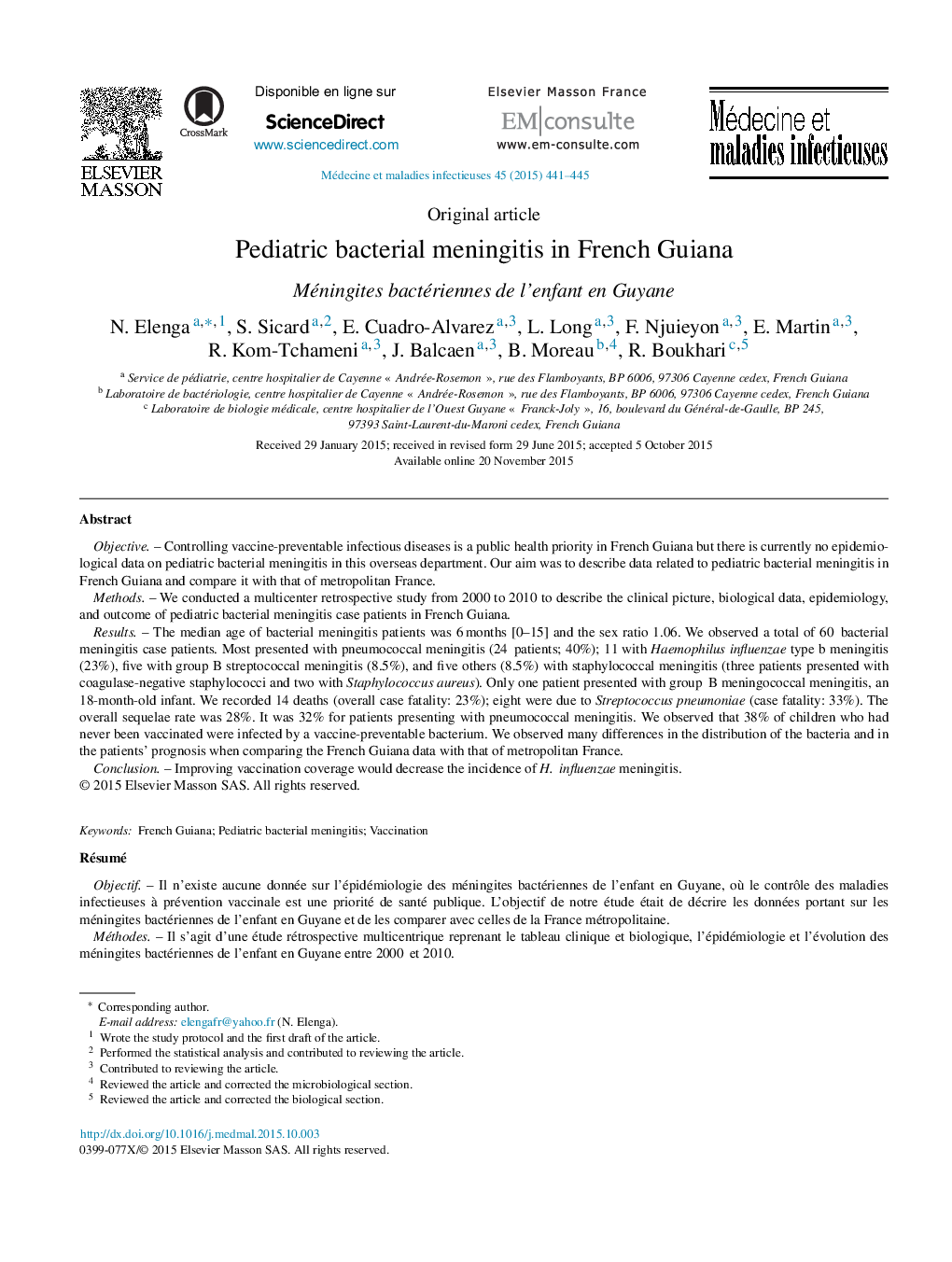| Article ID | Journal | Published Year | Pages | File Type |
|---|---|---|---|---|
| 3412434 | Médecine et Maladies Infectieuses | 2015 | 5 Pages |
ObjectiveControlling vaccine-preventable infectious diseases is a public health priority in French Guiana but there is currently no epidemiological data on pediatric bacterial meningitis in this overseas department. Our aim was to describe data related to pediatric bacterial meningitis in French Guiana and compare it with that of metropolitan France.MethodsWe conducted a multicenter retrospective study from 2000 to 2010 to describe the clinical picture, biological data, epidemiology, and outcome of pediatric bacterial meningitis case patients in French Guiana.ResultsThe median age of bacterial meningitis patients was 6 months [0–15] and the sex ratio 1.06. We observed a total of 60 bacterial meningitis case patients. Most presented with pneumococcal meningitis (24 patients; 40%); 11 with Haemophilus influenzae type b meningitis (23%), five with group B streptococcal meningitis (8.5%), and five others (8.5%) with staphylococcal meningitis (three patients presented with coagulase-negative staphylococci and two with Staphylococcus aureus). Only one patient presented with group B meningococcal meningitis, an 18-month-old infant. We recorded 14 deaths (overall case fatality: 23%); eight were due to Streptococcus pneumoniae (case fatality: 33%). The overall sequelae rate was 28%. It was 32% for patients presenting with pneumococcal meningitis. We observed that 38% of children who had never been vaccinated were infected by a vaccine-preventable bacterium. We observed many differences in the distribution of the bacteria and in the patients’ prognosis when comparing the French Guiana data with that of metropolitan France.ConclusionImproving vaccination coverage would decrease the incidence of H. influenzae meningitis.
RésuméObjectifIl n’existe aucune donnée sur l’épidémiologie des méningites bactériennes de l’enfant en Guyane, où le contrôle des maladies infectieuses à prévention vaccinale est une priorité de santé publique. L’objectif de notre étude était de décrire les données portant sur les méningites bactériennes de l’enfant en Guyane et de les comparer avec celles de la France métropolitaine.MéthodesIl s’agit d’une étude rétrospective multicentrique reprenant le tableau clinique et biologique, l’épidémiologie et l’évolution des méningites bactériennes de l’enfant en Guyane entre 2000 et 2010.RésultatsL’âge médian était de 6 mois [0–15] et le sex-ratio de 1,06. On notait une prédominance du pneumocoque avec 24 des 60 cas (40 %), suivi d’Haemophilus influenzae b (11 cas, 23 %) puis du streptocoque B et du staphylocoque (trois cas de staphylocoque à coagulase négative et deux cas de Staphylococcus aureus) avec cinq cas chacun (8,5 %). Il n’y avait qu’un seul cas de méningite à méningocoque B, chez un nourrisson de 18 mois. On dénombrait 14 décès (létalité globale de 23 %) dont huit étaient imputables au pneumocoque (létalité pour ce germe : 33 %). Le taux global de séquelles était de 28 % contre 32 % pour les méningites à pneumocoque. Parmi les enfants non vaccinés, 38 % présentaient un micro-organisme contenu dans un vaccin recommandé pour l’âge. La comparaison avec les données de la France métropolitaine montre de nombreuses différences dans la répartition des germes et le pronostic.ConclusionL’amélioration de la couverture vaccinale permettrait de diminuer la fréquence des méningites à H. influenzae.
